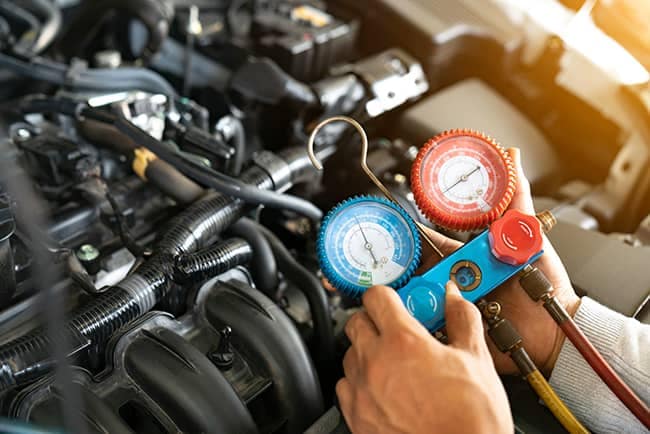To repair automotive air conditioning, first diagnose the problem, then replace or fix the faulty components. Common issues include refrigerant leaks, compressor failures, or electrical problems.
Automotive air conditioning systems require regular maintenance and occasional repairs to function properly. A malfunctioning air conditioning system can lead to discomfort, especially during hot weather. Diagnosing the problem accurately is the first step in the repair process. Common issues include refrigerant leaks, compressor failures, and electrical problems.
Addressing these issues promptly ensures a comfortable driving experience and prevents further damage. DIY enthusiasts can tackle minor repairs, while more complex issues may require professional assistance. Understanding the basics of automotive air conditioning repair can save time and money.

Introduction To Automotive Ac Repair
Automotive air conditioning keeps your car cool in hot weather. Learning to repair it can save money and time. Understanding the basics is the first step.
Importance Of Ac Maintenance
Regular AC maintenance extends the life of your car’s system. It ensures you enjoy a comfortable ride. Neglecting AC care can lead to costly repairs.
Consider these benefits:
- Improved air quality
- Enhanced cooling efficiency
- Longer system lifespan
- Reduced energy consumption
Schedule regular checks to avoid unexpected breakdowns.
Common Ac Problems
Understanding common AC problems helps you identify issues early. Here are a few typical problems:
| Problem | Description |
|---|---|
| Low refrigerant | Causes poor cooling. Check for leaks. |
| Compressor issues | Compressor failure stops cooling. Needs professional repair. |
| Clogged filters | Dirty filters reduce air flow. Clean or replace them. |
| Electrical problems | Faulty wiring can cause AC failure. Inspect and fix wiring. |
Address these issues promptly to keep your AC running smoothly.
Essential Tools And Equipment
Repairing automotive air conditioning requires the right tools. These tools make the job easier and more efficient. Below, we cover the essential tools and equipment you need.
Basic Tools
Every mechanic needs basic tools for air conditioning repair. These tools are easy to use and very important.
- Wrenches: A set of wrenches in various sizes is a must.
- Screwdrivers: Both flathead and Phillips screwdrivers are essential.
- Pliers: Needle-nose and regular pliers help with gripping small parts.
- Socket Set: A complete socket set helps with tightening and loosening bolts.
- Multimeter: This tool checks electrical connections and ensures safety.
Advanced Diagnostic Tools
For more complex issues, advanced diagnostic tools are needed. These tools help you identify problems quickly.
- Refrigerant Leak Detector: This tool helps find leaks in the system.
- Manifold Gauge Set: This set checks the pressure in the AC system.
- Vacuum Pump: It removes air and moisture from the system.
- UV Dye and Light Kit: These help locate leaks that are hard to see.
- Thermometer: Measures the temperature of the air coming from the vents.
Having these tools makes repairing automotive air conditioning much easier. With the right equipment, you can diagnose and fix issues efficiently.
Diagnosing Ac Issues
Diagnosing automotive air conditioning (AC) issues can seem daunting. Identifying the problem’s root cause is the first step. This section covers visual inspection and using a manifold gauge. These methods help find common AC problems.
Visual Inspection
A visual inspection is the simplest way to start diagnosing. Follow these steps to inspect your car’s AC system:
- Check for visible leaks around the AC components.
- Inspect the AC belts for cracks or wear.
- Look at the AC compressor for signs of damage.
- Ensure all connections are tight and secure.
- Examine the condenser for blockages or debris.
Use a flashlight to see hidden areas better. Look for oil stains. They can indicate refrigerant leaks. A proper visual inspection can reveal many issues quickly.
Using A Manifold Gauge
Using a manifold gauge set helps measure the AC system’s pressure. This tool provides insight into the system’s health. Follow these steps to use a manifold gauge:
- Attach the blue hose to the low-pressure port.
- Connect the red hose to the high-pressure port.
- Start the engine and turn on the AC to max.
- Read the pressure levels on the gauge.
Compare the readings to the manufacturer’s specifications. Low pressure can mean a refrigerant leak. High pressure might indicate a blockage. Both conditions need further investigation.
Using a manifold gauge can pinpoint issues not visible to the eye. Accurate readings guide the next repair steps.
Recharging The Ac System
Recharging your car’s AC system can bring back cool air. This process is simple but needs careful steps. Follow our guide to do it safely and effectively.
Safety Precautions
- Wear safety glasses to protect your eyes.
- Use gloves to avoid refrigerant burns.
- Work in a well-ventilated area.
- Keep flammable materials away from your workspace.
- Ensure the car is off before starting.
Step-by-step Guide
- Locate the AC service ports. The low-pressure port is usually on the larger tube.
- Attach the recharge hose to the low-pressure port. Ensure a snug fit to avoid leaks.
- Start the car and turn the AC to the highest setting. This helps circulate the refrigerant.
- Check the pressure gauge on the recharge hose. The ideal range is between 25-40 psi.
- Release refrigerant into the system. Hold the can upright and press the trigger.
- Monitor the pressure gauge. Stop recharging once it reaches the optimal range.
- Detach the recharge hose. Replace the service port cap tightly.
- Turn off the car and clean up your workspace.
Recharging your car’s AC system can be easy and safe. Follow these steps to ensure your AC works efficiently.
Fixing Refrigerant Leaks
Fixing refrigerant leaks in your car’s air conditioning system can be challenging. But with the right tools and knowledge, it becomes easier. This guide will help you detect and repair these leaks.
Leak Detection Methods
Detecting refrigerant leaks is the first step in fixing them. Here are some effective methods:
- Soap and Water Method: Mix soap and water in a spray bottle. Spray the solution on the suspected areas. Look for bubbles which indicate a leak.
- UV Dye Method: Add a UV dye to the refrigerant. Use a UV light to spot the dye escaping from leaks.
- Electronic Leak Detector: Use an electronic leak detector. This device senses refrigerant vapors and beeps when it detects a leak.
Repair Techniques
Once you have detected the leak, you can proceed to fix it. Here are some common repair techniques:
- Sealing Small Leaks: Use a refrigerant leak sealant. Add it to the system following the instructions on the product.
- Replacing Damaged Parts: If the leak is from a damaged part, replace it. Common parts include hoses, seals, and the condenser.
- Professional Repairs: For complex issues, seek professional help. They have specialized tools and expertise.
Here is a table summarizing the methods and techniques:
| Method | Description | Tools Needed |
|---|---|---|
| Soap and Water | Spray soap solution and look for bubbles | Spray bottle, soap, water |
| UV Dye | Use dye and UV light to spot leaks | UV dye, UV light |
| Electronic Detector | Detect refrigerant vapors with a device | Electronic leak detector |
| Sealing Leaks | Use sealant for small leaks | Refrigerant leak sealant |
| Replacing Parts | Replace damaged components | New parts, basic tools |
| Professional Help | Seek expert assistance | Professional services |
Taking care of your car’s air conditioning system is important. Use these methods and techniques to keep it running smoothly.

Replacing Ac Components
Repairing your car’s air conditioning can be a challenging task. One important part is replacing the AC components. These include the compressor, condenser, and evaporator. This guide will help you understand how to replace these parts.
Compressor Replacement
The compressor is the heart of your car’s AC system. It pumps refrigerant through the system. If it fails, the AC won’t cool. Follow these steps to replace it:
- Disconnect the battery to avoid any electrical issues.
- Remove the serpentine belt from the compressor.
- Disconnect the refrigerant lines using a wrench.
- Unbolt the old compressor and take it out.
- Install the new compressor and tighten the bolts.
- Reconnect the refrigerant lines and the serpentine belt.
- Reconnect the battery and test the AC system.
Condenser And Evaporator Replacement
The condenser and evaporator are crucial for cooling the air. The condenser releases heat, while the evaporator absorbs it. Follow these steps to replace them:
Condenser Replacement
- Disconnect the battery to ensure safety.
- Drain the refrigerant from the system.
- Remove the front grille to access the condenser.
- Disconnect the refrigerant lines from the condenser.
- Unbolt the old condenser and remove it.
- Install the new condenser and secure it with bolts.
- Reconnect the refrigerant lines and the front grille.
- Recharge the refrigerant and test the system.
Evaporator Replacement
- Disconnect the battery to prevent any electrical issues.
- Remove the dashboard to access the evaporator.
- Disconnect the refrigerant lines from the evaporator.
- Unbolt the old evaporator and take it out.
- Install the new evaporator and secure it with bolts.
- Reconnect the refrigerant lines and the dashboard.
- Recharge the refrigerant and test the system.
Replacing these AC components can restore your car’s cooling system. Always follow safety precautions and consult your car’s manual.
Maintaining The Ac System
Keeping your car’s AC system in top shape is vital. A well-maintained AC ensures comfort on the road. Regular maintenance prevents costly repairs down the line. Follow these tips to keep your AC system running smoothly.
Regular Check-ups
Schedule regular check-ups for your car’s AC system. Visit a trusted mechanic at least twice a year. They will inspect the system for any potential issues. Early detection helps prevent major problems. Regular servicing includes checking refrigerant levels and cleaning the filters.
Preventive Measures
Taking preventive measures can extend the life of your AC system. Here are some simple steps:
- Run the AC weekly, even in winter, to keep it in good condition.
- Keep the car’s interior clean to avoid clogging the filters.
- Check and replace the cabin air filter regularly.
- Avoid parking in direct sunlight to reduce the AC’s workload.
Following these tips can save you from expensive repairs. Keep your car’s AC system healthy and enjoy a comfortable ride all year round.

Expert Tips And Tricks
Repairing automotive air conditioning can be tricky. Here are expert tips and tricks to help you succeed. These tips will ensure your car’s AC runs smoothly. Follow these guidelines to avoid common pitfalls.
Maximizing Efficiency
Maximize your car’s AC efficiency with these steps:
- Check the refrigerant levels: Low refrigerant can cause poor cooling. Use a gauge to measure it.
- Clean the condenser: Dirt can block airflow. Use water to clean it.
- Inspect the cabin filter: A dirty filter blocks airflow. Replace it if dirty.
- Use the recirculation mode: This cools the car faster. It uses less energy.
Common Mistakes To Avoid
Avoid these common mistakes to keep your AC in top shape:
- Ignoring strange noises: Unusual sounds can signal problems. Investigate any noise immediately.
- Overcharging the refrigerant: Too much refrigerant can damage the system. Follow the manufacturer’s guidelines.
- Using the wrong refrigerant type: Always use the correct type. Check your car’s manual.
- Skipping regular maintenance: Regular checks prevent major issues. Schedule maintenance at least once a year.
Use these expert tips and tricks to repair your automotive air conditioning. By following these guidelines, you can ensure your car’s AC runs efficiently and avoid common mistakes.
Frequently Asked Questions
How Do I Know If My Car AC Needs Repair?
If your car’s AC isn’t cooling, makes strange noises, or emits a bad smell, it needs repair.
What Causes Car AC to Stop Working?
Common causes include refrigerant leaks, compressor issues, or electrical problems. Proper diagnosis is essential for effective repair.
Can I Repair the Car AC myself?
Basic tasks like replacing the cabin air filter can be DIY. For complex issues, professional help is recommended.
How Often Should I Service My Car’s AC?
It’s advisable to service your car’s AC annually to maintain optimal performance and avoid costly repairs.
Conclusion
Repairing automotive air conditioning can seem daunting, but it’s manageable with the right tools and knowledge. Follow the steps carefully and stay safe. Regular maintenance can prevent major issues. Don’t hesitate to consult a professional if needed. A well-functioning AC ensures comfortable rides in all seasons.




